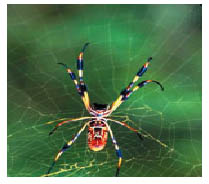The achievement by the research team is described in an article in a
recent issue of Current Biology. The development opens the way to
commercial development of this spider fiber for a variety of
applications.
Silk has been in use for thousands of years. However, unlike
silkworms, spiders are not subject to domestication and commercial
growth in practical quantities.
Scientists have attempted to create spider's webs independently of
the spider itself through genetic engineering by manufacturing the
proteins, which constitute the silk fibers of the webs, through the
use of bacteria,yeast, plants and mammalian cells in tissue culture.
But these efforts were unsuccessful in producing fibers with
properties similar to the natural material.
The Israeli-German scientific team has succeeded, through techniques
of genetic engineering, by creating spontaneous production of spider
web fiber in insect cell cultures. These fibers were equal in their
chemical resistance characteristics ,to those produced by the spider.
Mass production of such fiber in the future, can be used industrially
in various areas, which require fine applications. The Yissum
Research Development Company of the Hebrew University and German
partners are focusing on commercializing the research.
Spider webs consist of fibers (spider silks) produced by specific
proteins. In order to artificially synthesize these proteins, the
researchers utilized sections of the genes of the garden spider
(Araneus diadematus), which are involved in the manufacture of these
proteins.
The spider spins its web from various types of fibers, including the
fiber known as dragline silk, which is characterized by great
strength and elasticity. It is six times stronger than nylon and
steel fiber of equal diameter, and serves the spider as a "lifeline"
in case of falling. This fiber is made up primarily from two
proteins, ADF-3 and ADF-4, which are genetically similar and are
produced in a gland in the abdomen of the spider. The process by
which these proteins pass from the moment of their production until
their excretion, as fiber was not understood until now.
In their laboratory experiments, the researchers introduced the
genes, which encode the two dragline silk proteins, into an
insect-infecting virus, known as baculovirus. These genetically
engineered viruses were then grown in cultures of cells derived from
a type of caterpillar called the fall armyworm.
Since spiders and insects are both arthropods and since their genomes
are more closely related to each other than to those creatures with
which prior experiments were conducted, we felt that we would be able
to produce spider fibers using these insects," said the researcher.
"For this purpose, we developed a methodology for producing great
quantities of the appropriate proteins, which is based on infecting
the insect cells with the genetically engineered virus, in order to
produce the fiber.
After the engineered viruses infected the insect cells, the cells
began producing the proteins, and subsequently "spider" fibers
spontaneously formed in them. However, - unlike in spiders - these
laboratory-produced fibers were made up only of the ADF-4 protein,
while the ADF-3 protein remained dissolved. Nevertheless, these
fibers were identical in their diameter to that of real spider fiber
and were found to be equal to -- and in certain aspects even exceed
-- the chemical resistance quality of the spider-created fiber.
The scientists believe that that the variability in the behavior of
the proteins they produced as compared to what occurs in nature,
shows a high level of sophistication in the spider fibers. It seems
that the protein ADF-4 makes it possible for the rapid production of
fiber, while the other protein, ADF-3, regulates production and
prevents early fiber production, which could be fatal to the spider.
The researchers are now hoping to be able to create conditions, which
will make it possible to produce the spider fibers in quantity
without the limitations of having to do this within insect cells.
"The research enabled us to determine the close connection that
exists between the sequence, structure and functions of the
proteins," said Dr. Gat. "From a practical viewpoint, mass production
of fibers, whose diameter is one-thousandth of a millimeter, is
likely to be useful in the future for manufacture of bulletproof
vests, surgical thread, micro-conductors, optical fibers and fishing
rods; even new types of clothing may be envisioned."
 Scientists from the Hebrew University of Jerusalem and from Germany
have succeeded in producing self-assembled spider web fibers under
laboratory conditions, outside of the bodies of spiders. This fiber
is significantly stronger than the silk fiber made by silkworms.
Scientists from the Hebrew University of Jerusalem and from Germany
have succeeded in producing self-assembled spider web fibers under
laboratory conditions, outside of the bodies of spiders. This fiber
is significantly stronger than the silk fiber made by silkworms.